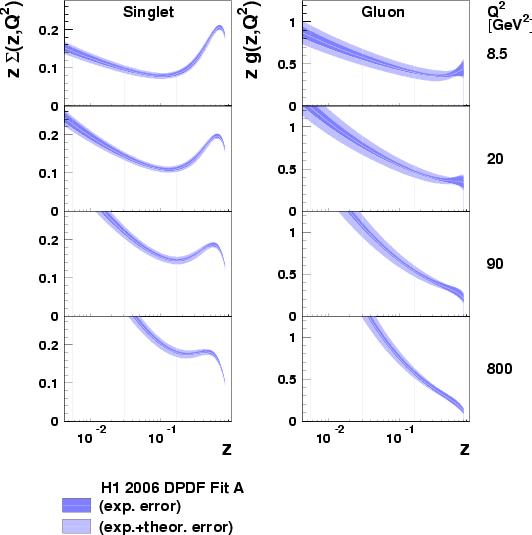Unexpectedly for many physicists, diffractive scattering has become an
important topic in deep-inelastic scattering (DIS) at HERA (see e.g.
here )
and in the study of hadronic interactions at low Bjorken-x in general.
The processes of interest are of the type ep --> eXp, with the proton
barely scratched in the interaction, losing typically 1% of its longitudinal
momentum and obtaining a transverse momentum of order only 100 MeV. Since the
proton remains intact, the diffractive exchange with which it interacts
(often referred to as a "pomeron")
must have the quantum numbers of the vacuum, though its microscopic description
in terms of quarks and gluons is not well known. The interaction of this
exchange with the electron leads to the system X being
"diffracted into existence". The unique benefit of studying such processes
in DIS is that this interaction between the diffractive exchange and the
electron takes place via a highly virtual intermediate photon, whose
resolving power is sufficient to probe the quark and gluon
structure of the exchange.

In this paper, the cross section for diffractive DIS is measured to an unprecedented precision (typically 7%) over a much extended kinematic range, extending to photon virtualities of 1600 GeV2, with 833 data points reported in total. Events are selected on the basis of their topology, by requiring an absence of activity in the outgoing proton direction, which is heavily populated by fragments of the proton in non-diffractive events. This leads to excellent statistical precision at the expense of enhanced systematics associated with the non-observation of the scattered proton, which is lost down the beam-pipe. In a companion paper , the subset of events for which the scattered proton is observed in a "Roman pot" spectrometer 60m downstream is studied in order to control these systematics.
The measurements shed fresh light on the properties of the diffractive exchange, in particular its description at the level of quarks and gluons. The figure on the right shows the "diffractive parton densities" (DPDFs) extracted from the cross section data. The dominant feature is the gluon density, which carries around 70% of the total exchanged momentum throughout the measured phase space, compared with 30% by quarks (labelled `singlet'). For the first time, the uncertainties on the DPDFs are assessed. The quark density is known to typically 5%, with the gluon density known to 15% at low momentum fractions z, the precision deteriorating considerably at larger z.
According to QCD, these DPDFs should be applicable to the prediction of more exclusive cross sections in DIS. Successful comparisons have been made for jets and open charm production. They are also an important ingredient in predicting diffractive processes in proton-proton scattering at the Tevatron and the LHC. This is most notably relevant to the prospects of discovering the Higgs boson diffractively at the LHC.
For the first time, the measurement is also extended to diffractive charged current interactions, in which the virtual photon exchange is replaced by a weak W boson. The results are compatible with the predictions based on the DPDFs above. The dynamics of the diffractive and total DIS cross sections are also compared in detail, with the conclusion that the quark and gluon compositions of the two are remarkably similar where valence quark effects can be neglected. In this sense, the measurements are about as close as one can get to the study of the QCD activity that takes place in the vacuum.